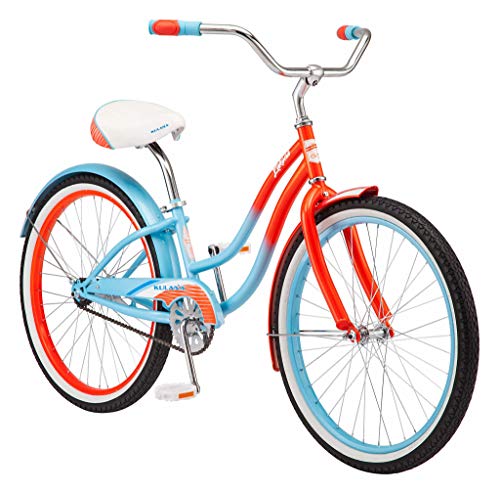How's it going RRB! New to the forum and need some help. Just finished my Dyno Roadster and noticed that the steer tube has up and down play when pushing the handlebars forward. What could be causing this problem? Thanks!
You are using an out of date browser. It may not display this or other websites correctly.
You should upgrade or use an alternative browser.
You should upgrade or use an alternative browser.
Movement/Play in steer tube
- Thread starter D-Cruiser
- Start date

Help Support Rat Rod Bikes Bicycle Forum:
This site may earn a commission from merchant affiliate
links, including eBay, Amazon, and others.
You need to adjust the headset. I assume threaded headset looking at pictures of other Roadsters.
From Park Tool http://www.parktool.com/blog/repair-hel ... ice#adjust
From Park Tool http://www.parktool.com/blog/repair-hel ... ice#adjust
- Use a headset wrench to hold lower race (adjustable race).
Using a large adjustable wrench or the Park Tool headset wrench HW-2, turn locknut counter-clockwise to loosen. Lower race is now free to turn.
By hand, turn lower race clockwise until it contacts ball bearings.
Turn race back counter-clockwise at least 1/4 turn from this setting. Hold adjustable race with headset wrench and tighten locknut. Tighten locknut fully, see Appendix B for torque. This early setting is intended to have play.
Check for play by pulling back and forth on fork. A knocking sensation indicates play. Turn the handlebars in different directions while checking for play. There should be play at this early setting. If headset feels tight, loosen adjustment further until play is found. Use care with suspension forks, because the legs may have play in sliders. Grab upper portion of fork.
If play is present, grab front wheel between knees and hold it in line with top tube. Lower adjustable race will need to be adjusted SLIGHTLY clockwise. Use a wrench to hold lower race and note orientation of wrench.
Loosen locknut and move wrench holding adjustable race clockwise 1/32nd of a turn. Front wheel must be straight to gauge adjustment.
Hold adjustable race from moving and tighten locknut fully. Check again for play, rotating fork and checking different positions.
If play is present, repeat steps "6" and "7" above until play disappears. Adjustment is finished when there is no play in any position as the fork rotates.
Does it have a threaded or threadless headset?
I would keep the stem tightened and remove the top cap, check the top of the steerer tube spacing to the top edge of the stem. If it's less than 3mm or so you might need another thin spacer under the stem. If there too little space the top cap will bottom on the steerer tube preventing the top cap from fully tightening down the headset. Or if you don't have any handy and it's pretty close you can try filing down the top of the steerer, bit I'd go with the spacers first.

$18.99
Old River Outdoors Bicycle/Motorcycle Chain Picture Frame 4" X 6" Photo - Faux Bike Chain
Old River Outdoors (USA Merchant)

$36.99
sthus CNC 36T Sprocket with 1.5" Adapter Fit 60cc 66cc 80cc Motorized Bicycle(Silver)
WoziMachineDoctor

$19.99
Electra Glide Wall Decal 2ft Long Sport Harley Davidson Bike Motorcylce Sticker Man Cave Garage Boys Room Decor
FatCat Wall Graphics
I like to loosen the clamp on stem bolts a bit so the stem 'floats' when doing this.The fork leg pinch bolts on the top tripletree clamp should also be lossened. You still need to check under that little center cap to make sure there is clearance to the steer stem proper so you dont bottom out.
With the stem loose you tighten the center bolt to get similar results as mentioned if it were a threaded set. Once the adjustment is spot on square up the stem and bars and tighten down.
By doing it this way the fork does not come out of adjustment 'cause the stem cant move up or down. You can even change stem/bar assemblies (a way easy way to quickly change the look or handling of a bike) and just have to reset that centerbolt torque and you are good to go. The top triple tree clamp helps hold all that together, unlike a std. fork, so pay some attention to that in the process. The idea is that all those top parts get the bearingset to the tension you need and are locked in place. Then the stem just pops on and off and the centerbolt doesnt do as much as one without a top tripletree clamp
With the stem loose you tighten the center bolt to get similar results as mentioned if it were a threaded set. Once the adjustment is spot on square up the stem and bars and tighten down.
By doing it this way the fork does not come out of adjustment 'cause the stem cant move up or down. You can even change stem/bar assemblies (a way easy way to quickly change the look or handling of a bike) and just have to reset that centerbolt torque and you are good to go. The top triple tree clamp helps hold all that together, unlike a std. fork, so pay some attention to that in the process. The idea is that all those top parts get the bearingset to the tension you need and are locked in place. Then the stem just pops on and off and the centerbolt doesnt do as much as one without a top tripletree clamp


























































